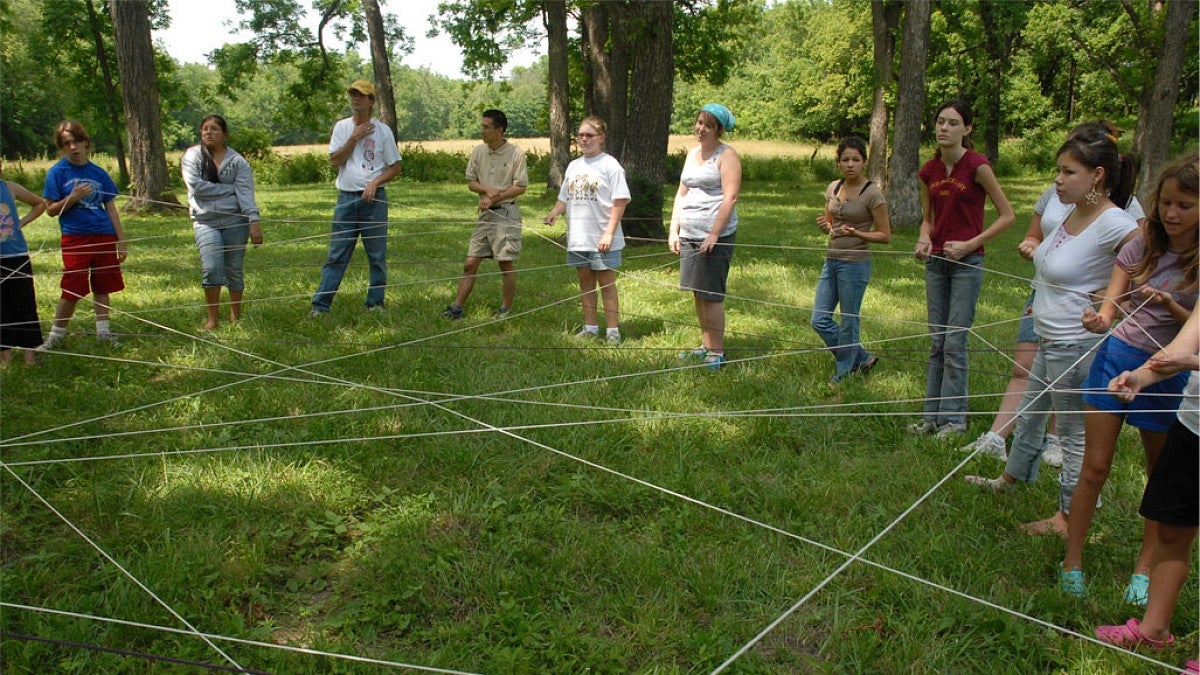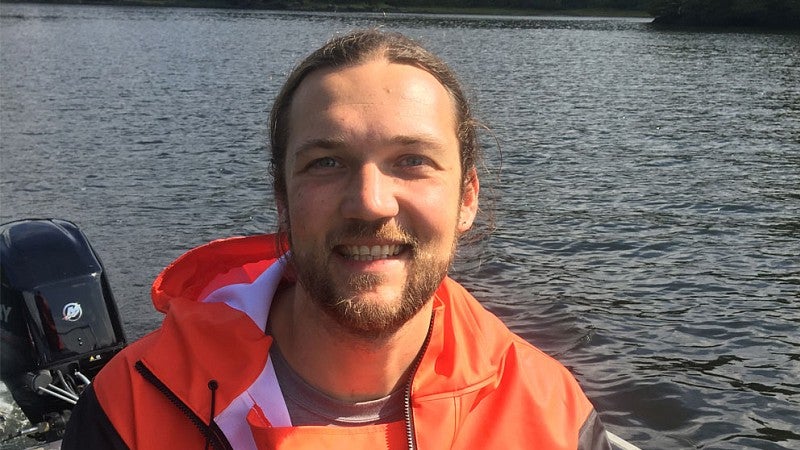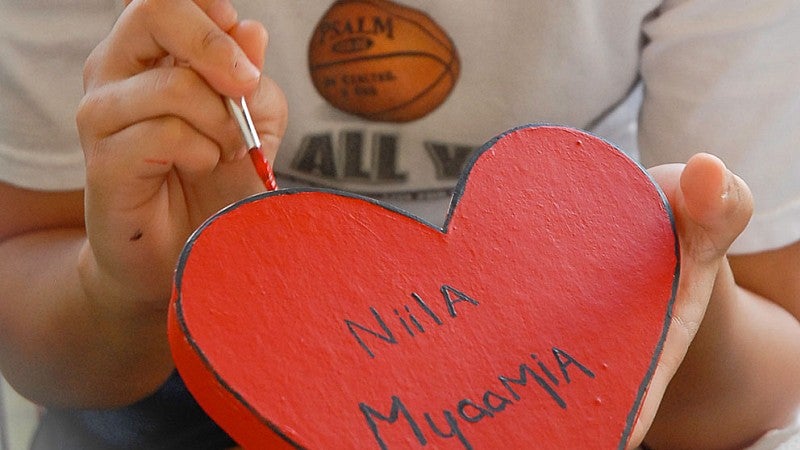
Experiential Learning | Research & Innovation | Community Impact | Career Preparation | Teaching Excellence | 21st Century Liberal Arts | Building Community | Good Vibes | CAS Spotlights | All Stories | Past Issues

April 26, 2024
Reweaving Cultural Threads
Weaving together the threads of a language and community torn apart by oppression is a big task, but it’s an important one for Carson Viles.
Growing up in an Indigenous community in southern Oregon, Viles was only vaguely aware that his ancestors spoke a language other than English—until he started taking classes in high school from the Confederated Tribes of Siletz Indians, a community representing 27 tribes of Indian peoples who were forcibly removed from across western Oregon to the Siletz Reservation in the 1850s.
Viles, who graduated from the University of Oregon in 2013, discovered a passion for Nuu-wee-ya’/Dee-ni’ Wee-ya’, a critically endangered Dene language from southern Oregon and northern California. He continued taking classes while attending UO, both through his own tribe and through the Northwest Indigenous Language Institute. Now a teacher—as well as learner—of his heritage language, he’s part of a community-wide language revitalization effort that started as early as the 1950s.

Wu’ nalh-de // Brushing teeth
Si’ taa-tr’ay-k’wvt // Combing hair
“On a community level, I am a firm believer that one of our fundamental rights as human beings is to have access to our cultural heritage, including real opportunities to learn and speak our heritage languages,” he says. “For my own community, I want to be part of the process of maintaining and repairing our family connections to our heritage and our cultural responsibilities, which I see tied to our wellness as people. Speaking our language is a central part of that.”
Language awakening is part of an ongoing effort to help Indigenous communities revitalize their languages and cultures after long periods of forced dormancy and even when no one is alive who speaks the language. While Indigenous tribes have been doing this work for decades, a growing movement within the field of linguistics aims to assist with these efforts.
“There was a long period of time when there was little in the way of collaboration between communities and linguists, and during which linguistics was not practicing with a social conscience.” says Gabriela Pérez Báez, associate professor of linguistics and director of the Language Revitalization Lab in the UO College of Arts and Sciences. "That has changed, thankfully. And linguistics is a very different discipline than it was 30, 40 years ago."
According to the Glottolog, a comprehensive catalogue of the world’s languages, more than 7,000 languages are used around the globe. However, language diversity has been declining worldwide for hundreds of years due to socio-cultural, political and economic factors. As many as 46% of the world’s languages are considered endangered.
When communities of people are oppressed, such as Indigenous tribes in the US and globally, they are often stripped of their language, identity, roots and traditions. Language awakening, especially when done within a community, is proving that revitalizing from a point of dormancy is possible.
Leading the way on language awakening
Language revitalization is on the rise in part because of the growing contribution being made by practitioners and scholars like Viles, who are doing the work in their own communities. Linguistics researchers are increasingly exploring their ability to meaningfully contribute to this work by making available theories and methods to the service language communities.
At UO, the call to redirect the attention of the linguistics discipline toward social impact has been longstanding. More recently, the Language Revitalization Lab, established in 2018 by the Linguistics department to support language revitalization efforts both regionally and internationally, provides a training ground for members of tribal communities who can then take their knowledge, experience and resources back to their communities.
“Language revitalization is never just about language. It's part of a broader community revitalization effort,” Pérez Báez says. “Here in Oregon, we are surrounded by Native American communities whose languages are being revitalized from a point of dormancy or near dormancy. I am working with students who are coming to linguistics because they want to engage in linguistic analysis for the purposes of language awakening.”
Through her work with UO students, alumni and faculty in the Language Revitalization Lab, Pérez Báez was inspired to publish a special volume about awakening languages through Living Languages, an international, multilingual journal dedicated to language revitalization and sustainability. Published in 2023 with funding from a CAS Presidential Fellowship in Humanities Studies, the peer-reviewed volume brings together language revitalization practitioners from both academic and non-academic backgrounds in the first volume-length work dedicated entirely to the needs of communities whose languages are being revitalized after a period without speakers.

Because existing literature on language awakening focused on relatively few case studies, Pérez Báez, co-founder and co-editor of Living Languages, sees this volume as a chance to broaden the conversation and create more opportunities for sharing information across Indigenous communities around the world.
“In the papers in the volume, you see a focus on what language revitalization can do for the revitalization of the community itself,” says Pérez Báez, who also received an award from the National Endowment for the Humanities in April 2024 for her work on the endangered language, Diidxaza, a language spoken in Oaxaca, Mexico, for a trilingual Diidxaza-Spanish-English dictionary. “There's evidence everywhere around the world that languages can be reawakened, even when there are no longer people who speak the language.”
Many of the contributed articles come from members of communities engaged in language awakening in the Pacific Northwest, Northern California, Oklahoma, Australia, Mexico, Costa Rica and Nepal. The volume also includes an article examining community efforts to reconnect through language in Africa.
“There are communities in Nepal that are trying to do, broadly speaking, similar kinds of things as Indigenous communities in the United States. Or on a very broad, high-level view similar things are happening in parts of Latin America or across the African continent,” says Justin Spence, co-editor of the volume. “When Gabriela explained the project to me, I thought, ‘Oh, wow, this is really going to be a unique and valuable contribution to the literature.’”
An important part of growing the literature on language awakening is providing methods to do it successfully. In one of the articles, Keli Yerian, director of the Language Teaching Studies master's program at UO, explores a multicompetence approach to awakening dormant languages with co-authors Connor Yiamkis from University of California, Davis and Jarrid Baldwin from Miami University.
“My co-authors both approach learning and teaching in ways that resonate with recent scholarship on 'multicompetence', which recognizes that learners already have many communicative competencies that can support the language they are trying to re-grow,” Yerian says.
The whole volume is a way to build community with others who care about preserving and growing languages that are disappearing, and to inspire those who are learning about it for the first time.
In another contributed article, Viles charts his journey as a learner and teacher of Nuu-wee-ya’ and shares his reflections on approaches for building and maintaining an active speech community.
“I feel very lucky to get to know and learn from so many brilliant thinkers, Native and non-Native alike. I was excited to take part in this volume because of its focus on being useful to Indigenous communities, and because it includes a broad range of perspectives and voices,” Viles says. “I'm not currently working in academia, so it was also a way for me to stay connected to the research world, which has some really powerful tools and lessons that can be put to use to support our language revival.”
Using linguistics to make an impact
Edgar Pérez Ríos, one of the volume’s contributors, believes that because languages are so closely linked to the territories in which they arose, reviving them is not only possible but essential.
“In my view, language awakening is important for the very speakers as well as for others. Much knowledge is transmitted through language, knowledge related to the land and its plants and animals,” Pérez Ríos says. “For example, the behavior of certain animals sends out messages about the weather, and this is taught through Indigenous languages. If the languages are lost, the associated knowledge could also be lost.
“It is also important to sustain languages for their historical and cultural value and to show that multilingualism is possible even within our globalized contemporary society.”
Many researchers believe language revitalization is work that is done best in collaboration with Indigenous communities to ensure Indigenous sovereignty is prioritized.
“As a public institution, it's important to know that we can have an impact and contribute to the language awakening work tribal communities are doing in the region,” Pérez Báez says. “It’s also important that non-Native people learn about the efforts being made and to have a better understanding, a better perspective on history and the impact on contemporary Indigenous communities.”
Pérez Ríos also sees the benefits of awakening a language extending beyond specific communities of speakers.
“A benefit that individuals external to a language community might derive from the awakening of a language is intercultural understanding which will lead them to learn about a diversity of ways to understand and name the world,” Pérez Ríos says. “These benefits can be of a cultural nature because a healthy linguistic diversity is indicative of a society that holds the respect for others highly."
To learn how scholars and community members are revitalizing dormant and endangered languages around the world, read the peer-reviewed contributions in Living Languages.
The author of this article and subjects included who represent the University of Oregon campus recognize that their work is being done on Kalapuya Ilihi, the traditional homelands of the Kalapuya People of the Willamette Valley, whose descendants are now citizens of the Confederated Tribes of Grand Ronde, the Confederated Tribes of Siletz Indians and other tribes in the Pacific Northwest.
—Jenny Brooks is a communications coordinator for the College of Arts and Sciences.
Audio Transcript: Carson Viles Learning Nuu-wee-ya’
Carson Viles ’13 is a learner of Nuu-wee-ya’, a Dene language from southern Oregon and northern California. In his article about language awakening in Living Languages, he shares his perspectives on using a home-based revitalization method called “language nesting.” The method focuses on building a dedicated space where you exclusively speak the target language.
Viles chose his bathroom as his language nest, where he practices his heritage language self-narrating his daily activities. Here's an example of his morning routine narrated in Nuu-wee-ya’.
Wu’ nalh-de // Brushing teeth
Shghu’ nashlh-de jii-dvn
I’m brushing my teeth now
See, wu’lh-nal-de, wu’lh-ch’vl-wvsh hii-chu ‘vshlh-chut.
First, I grab the toothbrush and toothpaste.
Wu’lh-ch’vl-wvsh wu’lh-nal-de k’wvt nush-lhe.
I put the toothpaste on the toothbrush.
Hat hii ‘vshlh-srvlh.
Then I wet the brush.
Jii-dvn shghu’ nashlh-de.
Now I brush my teeth.
Si’ taa-tr’ay-k’wvt // Combing hair
Shghu’ shu’ naa-sishlh-dee-‘vt shsi’ taa-tr’esh-k’wvt
When I’ve finished brushing my teeth, I comb my hair.
See shsi’ xashlh-t’vm’, hat si’-dvl-k’wvt yash-‘vsh
First I untie my hair, then I pick up the brush/comb
Shsi’ taa-tr’esh-k’wvt
I’m combing my hair
Shii-du’ shu’ shul-‘i ‘ushlh-te.
I want to look good!
